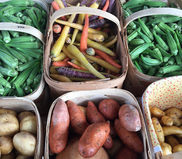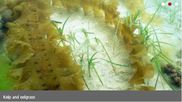|
|
|
Fresh from the Field is a weekly album showcasing transformative impacts made by grantees funded by the National Institute of Food and Agriculture.
June 15, 2017
|
|
Success Stories
 Farm ditch is home, sweet home, to tiny aquatic species
Seasonal agricultural streams and flooded
ditches, remnants of when the Willamette Valley was one big wetland, are full
of aquatic life. Scientists at Oregon State University (OSU) ventured
into farmers’ flooded fields in southern Williamette Valley and discovered that this biodiversity persists. They found a variety of crustaceans, snails,
worms, aquatic insects, fish, and amphibians.
These findings and others gathered over a decade’s study challenged the popular assumption that agricultural streams and ditches are poor habitat.
The research offers guidance for farmers who want maintain the
health of these temporary waters by setting aside low areas of their fields
that consistently flood and have low yields.
Among the key findings, streams and ditches with less
watershed agricultural land-use contained more species of macroinvertebrates. Channels
with the most watershed agricultural land-use lacked many of the aquatic
insects found in less agriculturally influenced channels. Stream and ditch
bottoms with grasses and other plants had more invertebrates than those with
exposed clay bottoms.
The
project was made possible with support from NIFA’s Partnership in Conservation Effects Assessment Project (CEAP).
Read more about OSU's research.
|
 Urban farm in Arizona
Tucson Village Farm (TVF) is a working urban farm built by and for
the youth of Pima County, Arizona. A 4-H program from the University
of Arizona Cooperative Extension, TVF is a seed-to-table program that reconnects
young people to a healthy food system, teaches them how to grow and prepare
fresh food, food budgeting, and empowers them to make healthy life choices. The
year-round, hands-on program focuses on the building the soil, integrative pest
management, weed management, crop rotation, and cover cropping. TVF hosts more
than 2,000 community members at a harvest fair and youth programs such as
“Growing Forward” for K-5th graders and “L’il Sprouts” for tots.
Read more about the Tucson
Village Farm.
|
 Kelp, commerce, and cleaner water
Only 80 miles east of New
York City, the Peconic Estuary on Long Island remains relatively pristine. Over
time, the wetland is being affected by development and harmful algal blooms,
like the brown tide that devastated the local scallop industry in 1985. The Cornell
Cooperative Extension in Suffolk County, New York, is investigating whether
sugar kelp can be grown commercially and help improve local water quality.”Part of our
project is not only testing feasibility for growth of kelp, but also to see
whether or not there is a ready market and how we can collaborate with
businesses on Long Island to produce it and grow it and hopefully sell it in
the future,” said Chris Pickerell, marine program director at Cornell Cooperative Extension Suffolk County. Pickerell says the sugar
kelp can be used for food, fertilizer, and even medicine. It also helps the
environment because kelp removes nitrogen and carbon from the water
Read more about the Suffolk County Extension aquaculture study.
|
News Coverage
 Citrus greening and Florida
University of Florida (UF) researchers are a step closer to finding a treatment for a
disease called Huanglongbing (HLB), or citrus greening, which has decimated
citrus trees in the state. The project was funded through NIFA’s Specialty Crop Research Initiative (SCRI).
The investigators looked
at the Asian citrus psyllid (ACP), which transmits the HLB bacteria from one
plant to another. Scientists discovered that the psyllid contains another
bacterium, Wolbachia bacterium, that “cross talks” with the HLB bacterium. This
interplay prevents an insect immune reaction that could harm both bacteria.
The Wolbachia bacterium
could be a source for future spray treatments to protect trees against the
psyllids, and could help the trees fight off bacterial invasion, said senior
study author Dean W. Gabriel, Ph.D., a professor of Plant Pathology at the
University of Florida.
Read more about UF's citrus
greening research at Science Daily.
|
 How food systems affect health
Researchers and extension specialists involved
in the NIFA-funded Multistate Research Fund project are engaging communities and
facilitating institutional, family, and individual changes that improve health
and wellbeing. One such project has investigated how food systems affect human
health. Over the past five years, the project has produced a “hunger atlas” for
the state of Missouri and a regional profile of Missouri food pantry clients.
Other outcomes include an overview of Maryland community stores and the “Seeds that Feed” program that
distributes vegetable seeds and training to Missouri food pantry clients.
Learn more about human health and food systems.
|
Video
 Nothing like Mississippi beef
Mississippi State University (MSU) Extension's Mississippi Master Cattle Producer Program focuses on improving
overall management and decision-making skills and developing a broad knowledge
base for beef cattle production. For every 100 participants trained through
the Mississippi Master Cattle Producer Program, there is potential to increase total
beef cattle production annual net returns by an estimated $825,000. For every
$1 million increase in value of cattle production, the expected impact on the
Mississippi economy exceeds $1.9 million including support for employment and
the tax base. This equates to an annual economic impact to date of greater
than $2.75 million as a result of this program. In addition to Mississippi beef
cattle producers, Mississippians from other segments of the beef cattle
industry, such as feed retailers, as well as out-of-state beef cattle producers
participate in the growing program
Watch the MSU Extension video.
|
#NIFAIMPACTS
Tweet of the Week

|
|

For more NIFA Impacts, visit nifa.usda.gov/impacts or the Land-Grant University Impacts website. Send us your NIFA-funded impacts at impactstories@nifa.usda.gov or share them on Twitter @USDA_NIFA, #NIFAimpacts.
NIFA invests in and advances agricultural research, education, and extension and promotes transformative discoveries that solve societal challenges.
Fresh from the Field is a weekly compendium of news and information that may be of interest to land-grant and non-land-grant universities, NIFA stakeholders, and other subscribers.
Editor: Falita Liles, Co Editor: Carlos Harris
|
|
|
|